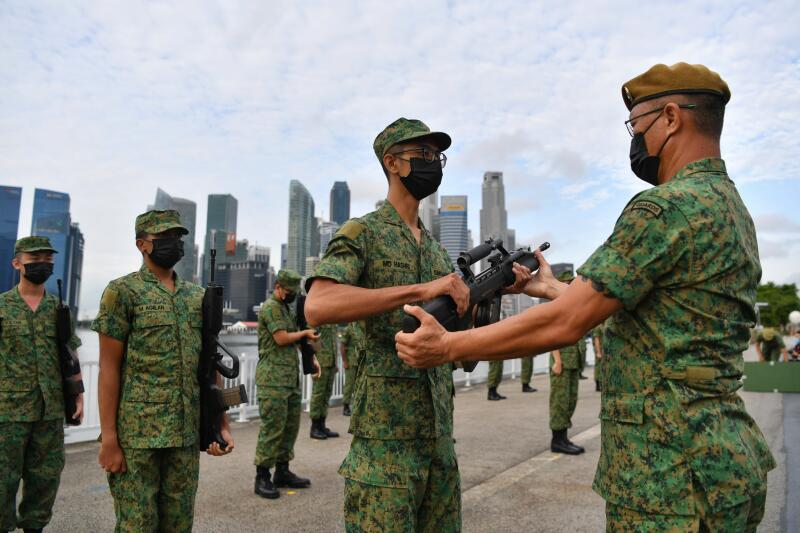askST: What lies behind the formation of the SAF's new intel and digital service?
Sign up now: Get ST's newsletters delivered to your inbox

The DIS can also facilitate greater mission focus, and sharpen direct responsibility and accountability, said Dr Ng Eng Hen.
ST PHOTO: CHONG JUN LIANG
Follow topic:
SINGAPORE - In response to the threat of hybrid warfare, Defence Minister Ng Eng Hen announced on Wednesday (March 2) that Singapore will set up a new branch of the military called the Digital and Intelligence Service (DIS) to complement the existing three services.
The DIS, to be formed this year, will bring together cyber and C4I (command, control, communications, computers and intelligence) units under one service, so that the Singapore Armed Forces can fight better as an integrated force.
The Straits Times answers questions related to this move, including threats that have emerged in the digital domain, the benefits of having a dedicated service, and who could helm the DIS.
What is hybrid warfare?
Hybrid warfare generally refers to the use of both conventional weapons as well as subversion - from disinformation to cyber attacks - to achieve political and strategic goals.
Dr Ng in 2015 described hybrid warfare as "an orchestrated campaign to fracture the solidarity of a target nation through undermining its defences in civil, economic, social, psychological and military spheres".
This was after Russia's 2014 annexation of the Crimean Peninsula, where provocateurs, as well as disinformation on social media, were used to cause disunity and dissent among the population, before military force was applied.
On Wednesday, Dr Ng said the divide between virtual and physical realms, in security terms, is a false one as the two are intricately interwoven.
For instance, fuel shortages across the United States east coast resulted in May last year (2021) after a ransomware attack on the Colonial Pipeline.
Other examples can be seen in the current Russia-Ukraine conflict, such as in the use of cyber espionage, planting of malware and false flag operations.
Why is a dedicated service needed?
One reason is the need for more headcount.
The demands and direct responsibilities on the intelligence community has risen sharply, said Dr Ng. Digital threats from external aggressors can be expected to grow in number, sophistication and organisation.
The current Defence Cyber Organisation, formed in 2017, is building up such a dedicated digital force, but it is insufficient for the SAF's expanding needs and mandate, he said.
"Figuratively, if the digital force is now a battalion force, we actually need a few brigades, perhaps even a division-size force".
A new service can therefore allow for better talent recruitment, professional development and career prospects.
The DIS can also facilitate greater mission focus, and sharpen direct responsibility and accountability, said Dr Ng.
The C4I Community - DIS' precursor - had in 2012 gathered C4 and intelligence units and personnel from across the SAF, which had up till then existed as separate entities.
But they remained under the command of their respective formation and command headquarters.
This will change under the DIS, which consolidates such units under one structure.
Do other militaries have similar outfits?
The closest example from abroad is the German military's Cyber and Information Domain Service, set up in 2017. The service has a strength of around 14,000 civilians and soldiers across various units and commands.
Beyond cyber defence, it is also tasked with military reconnaissance, geospatial sensing and defending against hybrid threats such as influence operations or disinformation.

Who will head the new service?
Dr Ng did not give further details on the structure and pinnacle appointment of the DIS.
But the army, navy, and the air force are all headed by two-star generals.
The highest-ranked officers in the existing cyber and C4I commands are both one-star generals: Defence Cyber Chief, Brigadier-General Mark Tan; and Chief C4I, Brigadier-General Ng Chad-Son.
In 2013, the first Chief C4I, then Rear-Admiral Joseph Leong, received his second star a year into the job, although subsequent chiefs have been of one-star general rank.
Will national servicemen be able to serve in DIS?
Dr Ng did not give further details on who the DIS will be composed of. But there are already schemes for national servicemen to serve in cyber roles.
For instance, a scheme for full-time national servicemen (NSF) cyber specialists was launched in February 2018 to bring in and train NSF cyber talents to protect defence systems and networks.
Roles they fill include incident response, cyber forensics, malware analysis and penetration testing of Ministry of Defence and SAF's networks and systems.
The scheme, a partnership with the Singapore Institute of Technology, was expanded in 2020 with the National University of Singapore School of Computing coming onboard.
An expertise deployment centre was recently set up in the SAF to tap operationally-ready national servicemen with specialised skill sets, including in cyber security, to serve in relevant roles.
Other questions that remain unanswered include whether the DIS will have its own uniform, and the camps and bases where its units will be located.

